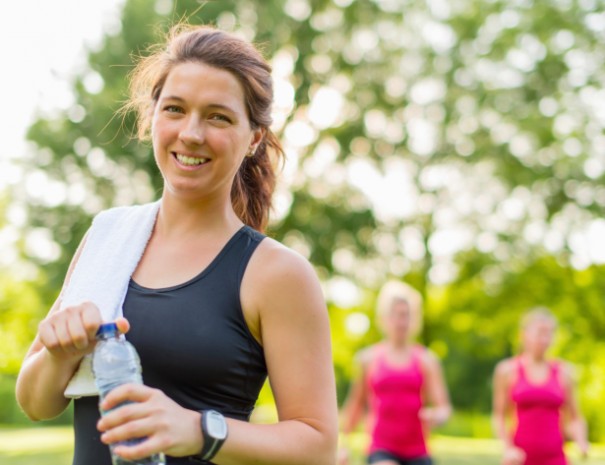 |
| Stay hydrated. |
BERKELEY WELLNESS, which is housed at the University of California Berkeley, has a wide variety of resources to help its users live a healthier lifestyle. They, too, have seen how much heat has enveloped this country and they have some recommendations about exercising safely in the heat.
When you're out in the heat, you have to consider that higher temperatures make it harder for your body to cool off. Add in the drenching humidity that many of us on the East Coast are experiencing, and the evaporative cooling that your body relies upon, struggles even more. You want to keep your body's core temperature from rising so much that you become ill, or even risk death, from heat exhaustion or heat stroke.
Their recommendations are based upon sound scientific research, which has typically been done on endurance athletes. But the same recommendations have some applications to average exercisers, as well. We'll look at exercise stages and what works.
Pre-Exercise
* Drink cold beverages before you begin exercising to cool your core temperature. Beverages cooled to around 40 degrees F are preferred. This gives you a better cooling effect than tap water and this cooler beverage temperature makes your drink more palatable, so you drink more. However, don't consume so much that you have a stomach ache or brain freeze before you begin exercising. If you wish, you can make an ice slurry by mixing 70% crushed ice with 30% tap water. You might also want to prepare a frozen bottled water or sports drink ahead of time to carry with you.
* You can also cool yourself externally by applying icy cold wet towels to your face, neck, arms, thighs, and other body surfaces for 5 to 20 minutes. The head and neck areas are particularly effective, even for a brief 5 minutes. If you want to use a wet towel during a break in exercise, cool a towel in an ice slurry or in the freezer for a few minutes, then wring it out. You can also buy cooling towels or gel packs over the counter. Don't bother with cooling clothes; they aren't that effective.
* Put your hands and upper arms in cool or cold water. This is actually more effective than pre-dosing with cold beverages. Most people, though, find this method to be less practical. However, if you do try this, the water should be 50 to 68 degrees F and limit the time in the water to only 10 minutes. Or you can also try carrying a bottle of cold water in each hand.
During Exercise
* Wear loose-fitting lightweight clothes that are lighter in color, since darker colors absorb more heat. There is no particular recommendation about fabric, but wear something that clings less, or has a less clammy feel. Lighter and thinner materials are best.
 |
| Cold water for your head. |
Other Ways To Cool
If you aren't used to exercising in the heat, you might want to start out with shorter sessions and gradually add to the length over one to two weeks. Schedule exercise sessions for cooler times of day, do your routine in shady areas, and take frequent breaks to cool off. When the heat and humidity gets into the extreme range, you might want to exercise indoors in air conditioning, take the day off, or make those hot days your swimming days. Make sure you stay hydrated; drink fluids before you feel thirsty. Children, seniors, and overweight individuals need to be even more careful because they are less tolerant of heat conditions. Learn the early warning signs of heat stress - muscle cramps, fatigue, nausea, headache, heavy sweating. More serious signs, like dry red skin, confusion, and fainting, are signs of heat stroke and need immediate emergency treatment.
 |
| Exercise in the pool. |
Click here: DIGGAR AMAZON PRODUCT FINDER


No comments:
Post a Comment